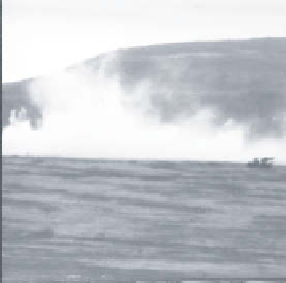Image Processing Reference
In-Depth Information
The result of the segmentation according to movement, obtained for the first image
of the sequence, is given in Figure 10.20. Five regions have been labeled, including
the vehicle, but also four other regions representing the concept “smoke”. Each area
appears as a potential target, based on which the analysis will continue.
Figure 10.20.
Segmentation of the moving areas: on the left, the reference
image is presented and on the right, the resulting segmentation
Taking into account information regarding movement makes it possible to very
quickly reach the area of interest, without waiting for the complete analysis related
to the spatial exploration. Furthermore, it leads to an increase in the probability of
membership to the vehicle concept. The probability obtained is 79%, whereas without
the movement information, the probability is 65%.
The Movement agent is a monitoring agent that allows a quicker decision to be
made regarding the possibility of a threat. On the other hand, this analysis in no way
alters the benefit of the spatial exploration, which segments the targets that are not
detected by the movement branch, either for reasons of computation time (depending,
for example, on the machine's load, etc.), or because the vehicle in question is not
moving.
Depending on the information available and the execution speed, the paths to the
segmentation of the target can be modified. The system can operate using an explor-
atory process based on contextual relations or on strong information such as move-
ment; this way, it adapts to the situations it encounters.
10.6.4.
Conclusion
In order to solve the problem of the detection, recognition and identification of
targets, we have proposed a multi-agent architecture based on the implementation of
agents which are located simultaneously in the image space, the goal space and the


Search WWH ::

Custom Search